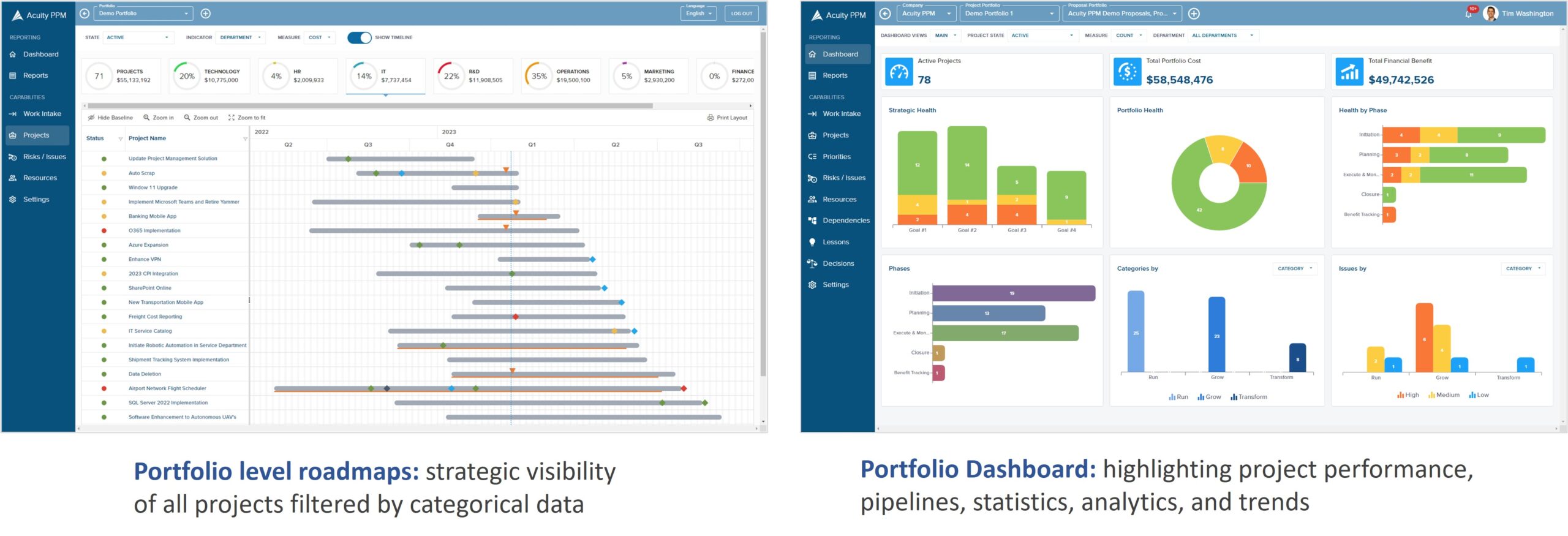The Portfolio Roadmap Communicates Value
Project portfolio management (PPM) is about maximizing business value delivery and the portfolio roadmap (or strategic roadmap) helps senior leaders track the delivery of that value. Senior leadership is uniquely responsible for ensuring that projects and programs within the portfolio deliver the expected benefits at the right time. Without adequate visibility to the portfolio and the completion of portfolio components, senior leadership will not be able to successfully manage the project portfolio. Governance is critical; in our previous post, we covered portfolio governance and the accountability framework and how it supports portfolio management. In this post we focus on using portfolio roadmaps to track value delivery and improve strategic performance.
What is a Portfolio Roadmap?
The portfolio roadmap is a graphical depiction of the portfolio shown on a timeline. When combined with other metadata, it can be a powerful tool for communicating what is in the portfolio and when work is expected to be completed. This graphical view has advantages over just reviewing the start and end dates of a project. By filtering on key metadata such as strategic goal, senior leaders can track progress against organizational goals and objectives and quickly see how many active projects support that strategic goal. When important project milestones are added to the roadmap, it further enhances the information being communicated to senior leadership by depicting key dates for each project. Moreover, if project managers provide milestone status and color code milestones (e.g. red, yellow, or green), an even more accurate graphical depiction of portfolio performance can easily be shared and quickly understood.
The portfolio roadmap is an important communication tool both for senior leadership and for the rest of the organization. Good portfolio roadmaps can be easily understood with little additional commentary. Organizations that do not produce good portfolio roadmaps often do a poor job of communicating strategic performance across the organization. Without a clear portfolio roadmap, senior leaders will not be well informed to manage the portfolio and may authorize the wrong projects at the wrong time.
When combined with other metadata, a portfolio roadmap can be a powerful tool for communicating what is in the portfolio and when work is expected to be completed.
A good strategic roadmap is also a critical element of portfolio planning. When too many projects complete at the same time, the impacted departments may not be able to absorb all the changes at once. Roadmaps provides critical visibility into project completions and can help senior leaders sequence projects so that impacted departments are not overwhelmed and can successfully absorb all changes from the respective projects.
When Should Roadmaps Be Used?
A portfolio roadmap can be used at both a strategic and tactical level. Let’s review the various meetings where a roadmap will add value to that meeting.
- Annual planning (strategic) – during annual planning meetings, senior leaders can zoom out and view a longer time horizon on their roadmap to see when certain projects complete or when products launch and use this information to evaluate when to initiate new projects. This supports both annual planning as well as strategic planning. If the organization does not develop a portfolio roadmap, how can it realistically expect to accomplish its strategic goals? As the saying goes, “hope is not a plan”.
- Portfolio review meetings (strategic) – periodic portfolio review meetings give senior leaders the opportunity to evaluate the long-term view of the portfolio in support of strategic planning discussions. At these times, decisions may be made whether to cancel in-flight projects or re-prioritize certain projects in the portfolio.
- Project governance meetings (strategic) – project governance meetings are another place where portfolio roadmaps can add incredible value. All proposed projects should have their own project roadmap to communicate value delivery as well as ensure that the proposed timing will meet strategic needs and not conflict with other project milestones. When a previously unidentified project is proposed, the governance team must ask whether the proposal promotes strategic success or gets in the way of key projects already on the roadmap.
- Status review meetings (tactical) – At a tactical level, a project roadmap can be used in status review meetings to zoom into a shorter time horizon and review milestone status of projects. This can be far more effective than reviewing status reports alone.
- Project manager meetings (tactical) – By looking at near-term milestones, Project Managers can have real-time tactical discussions to ensure that current milestone performance does not impact other dependent projects. In addition, a good roadmap will allow senior leaders to filter on strategic goals or other metadata and track strategic performance within status meetings.
In addition to the meetings mentioned above, roadmaps can help with ad hoc portfolio analysis or ad hoc communication across the organization to inform employees of current project and portfolio performance.
Roadmap Benefits
In summary, strategic roadmaps provides several benefits to the organization:
- It provides a clearly articulated message of what an organization is doing, when it is doing it and what is coming next
- It is a plan that matches short-term and long-term goals with specific solutions to help meet those goals
- It helps decision makers reach a consensus about a set of needs and the solutions required to satisfy those needs
- It draws attention to the most important work and the most critical issues
- It provides a mechanism to help forecast new project developments
- It provides a framework to plan and coordinate project work across teams and departments
- It helps manage expectations of what will get done by when
- It highlights project value delivery
Acuity PPM Project Portfolio Management Roadmap Software
Acuity PPM is an excellent lightweight project portfolio management solution that replaces spreadsheets. Acuity PPM helps you track project performance, report project and portfolio status to senior leaders, manage and prioritize incoming project requests, visualize strategic roadmaps, allocate resources and manage resource capacity. All of this helps enable strategic agility in a changing environment.

VIDEO: How to Build Great Strategic Roadmaps in Acuity PPM
Tim is a project and portfolio management consultant with over 15 years of experience working with the Fortune 500. He is an expert in maturity-based PPM and helps PMO Leaders build and improve their PMO to unlock more value for their company. He is one of the original PfMP’s (Portfolio Management Professionals) and a public speaker at business conferences and PMI events.
[activecampaign form=3]
The portfolio roadmap is a graphical depiction of the portfolio shown on a timeline. When combined with other metadata, it can be a powerful tool for communicating what is in the portfolio and when work is expected to be completed.
The portfolio roadmap is an important communication tool both for senior leadership and for the rest of the organization. Good portfolio roadmaps can be easily understood with little additional commentary. Organizations that do not produce good portfolio roadmaps often do a poor job of communicating strategic performance across the organization. Without a clear portfolio roadmap, senior leaders will not be well informed to manage the portfolio and may authorize the wrong projects at the wrong time.
A portfolio roadmap can be used at both a strategic and tactical level in the following ways: 1) Annual planning (strategic) – during annual planning meetings, senior leaders can zoom out and view a longer time horizon on the portfolio roadmap to see when certain projects complete or when products launch and use this information to evaluate when to initiate new projects. 2) Portfolio review meetings (strategic) – periodic portfolio review meetings give senior leaders the opportunity to evaluate the long-term view of the portfolio in support of strategic planning discussions. At these times, decisions may be made whether to cancel in-flight projects or re-prioritize certain projects in the portfolio. 3) Project governance meetings (strategic) – project governance meetings are another place where portfolio roadmaps can add incredible value. All proposed projects should be compared to the portfolio roadmap in order to ensure that the proposed timing will meet strategic needs and not conflict with other project milestones. 4) Status review meetings (tactical) - At a tactical level, a portfolio roadmap can be used in status review meetings to zoom into a shorter time horizon and review milestone status of projects. This can be far more effective than reviewing status reports alone. 5) Project manager meetings (tactical) - By looking at near-term milestones, Project Managers can have real-time tactical discussions to ensure that current milestone performance does not impact other dependent projects. What is a portfolio roadmap?
What is the purpose of a portfolio roadmap?
When are portfolio roadmaps used?
Never miss an Acuity PPM article
Don't take our word, listen to what others are saying:
"I find value in all of your articles."
"Your articles are interesting and I am sharing them with my team who have limited project knowledge. They are very useful."


